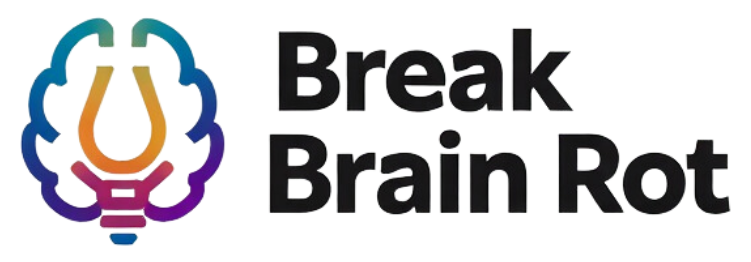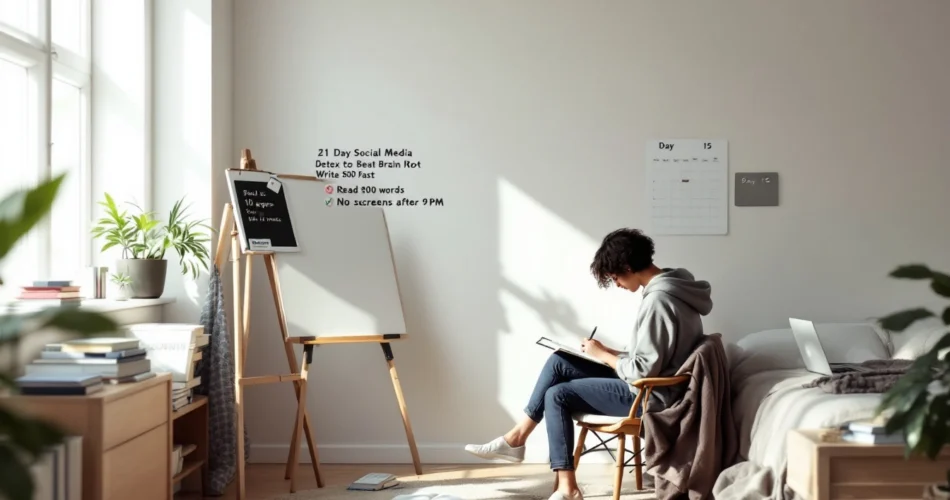Do you ever catch yourself unlocking your phone “just for a minute,” only to realize you’ve been scrolling for half an hour? You’re not alone. The endless cycle of swiping, liking, and double-tapping can leave your brain feeling foggy and drained—a state many now call “brain rot.” The good news? You can reclaim your focus, energy, and time with a structured 21 day social media detox plan. In this guide, you’ll learn how to reset your habits, clear away digital clutter, and start feeling sharper in just three weeks.
Table of Contents
- Why You Need a 21 Day Social Media Detox Plan
- How the 21 Day Social Media Detox Plan Works
- The 21 Day Social Media Detox Challenge – Step-by-Step Breakdown
- Benefits of Completing the 21 Day Social Media Detox Plan
- Tips to Stick With Your Social Media Detox Plan
- FAQs About the 21 Day Social Media Detox Challenge
- Conclusion
Why You Need a 21 Day Social Media Detox Plan
Modern life is dominated by screens, notifications, and endless feeds. According to Pew Research Center, the average adult spends hours daily on social media platforms. While they may help us connect, they also foster distractions, comparison loops, and reduced mental well-being.
The Problem of Digital Overload
Hours of daily scrolling contribute to anxiety, poor sleep, and diminished attention spans. Endless notifications provide dopamine bursts that keep you hooked, often replacing real-world experiences.
What “Brain Rot” Really Means
Brain rot isn’t a clinical term, but it perfectly captures the foggy, restless state that comes from overconsumption of fast, shallow content. Signs include loss of focus, heightened anxiety, and inability to stay present. For more, see our guide on digital burnout.
Why 21 Days is the Perfect Reset
Science suggests it takes roughly three weeks to build or break a habit. As James Clear notes, consistent effort reshapes routines. That’s why a 21-day detox period is long enough to reset behaviors without feeling unmanageable.

How the 21 Day Social Media Detox Plan Works
This 21-day social media detox challenge unfolds in stages, making it easier to adapt and stick with.
Stage 1: Preparation (Days 1–3)
- Reflect on why you want to detox.
- Silence notifications and begin announcing to friends you’ll be less available online.
- Stock up on books, a journal, or podcasts to fill idle moments.
Stage 2: Adjustment (Days 4–10)
This is the hardest stage as cravings for mindless scrolling kick in. You’ll feel FOMO or boredom. Replace that urge with healthier activities like journaling, morning walks, or new skill learning.
Stage 3: Transformation (Days 11–21)
This phase feels lighter—your sleep improves, your mind clears, and you notice regained time. Strengthen your habits with mindfulness practices. Try these mindfulness techniques to keep momentum.
The 21 Day Social Media Detox Challenge – Step-by-Step Breakdown
Each week builds on the last with specific goals and routines.
Daily & Weekly Goals
- Week 1: Reduce usage to under one hour/day. Track cravings in your journal.
- Week 2: Delete apps temporarily. Replace scrolling time with outdoor walks or creative tasks.
- Week 3: Stay fully off social media. Focus on your reflections and create new offline routines.
Alternative Activities
During your detox, try timeless activities:
- Fitness routines or yoga sessions
- Reading a curated book list
- Creative habits like painting, writing, or cooking
- Strengthening offline social ties through meetups or phone calls
Accountability
- Partner with a detox buddy.
- Install blockers like Freedom or RescueTime.
- Share weekly reflections with close friends.
Benefits of Completing the 21 Day Social Media Detox Plan
Mental and Emotional Benefits
A detox reduces stress, anxiety, and constant comparison. Confidence rises as your attention shifts inward rather than outward.
Productivity Benefits
You’ll notice better concentration and more energy to achieve meaningful goals. A detox fosters effective time management, freeing hours daily.
Lifestyle Transformation
With regained hours, you can explore hobbies, deepen relationships, and invest in growth. Check our productivity hacks for added inspiration.
Tips to Stick With Your Social Media Detox Plan
Overcoming Withdrawal
Every time you feel the itch to scroll, swap it with a grounding activity. Write one sentence in your journal or do breathing exercises.
Building a Phone-Free Environment
- Turn off non-essential notifications.
- Keep your phone out of reach during work or meals.
- Create phone-free morning and evening routines.
Sustainable Long-Term Balance
Once the 21 days end, don’t fall back into old habits. Set weekly app usage limits or practice regular digital fasts. The Harvard Health Blog has great insights on digital health for long-term balance.
Frequently Asked Questions
Is 21 days really enough to break my social media habits?
Yes. Studies show 21 days is a strong period for habit formation, though continuing moderation afterward will deepen results.
What should I expect in the first week of the detox?
You may feel restless or anxious at first as your brain craves the dopamine hit from social scrolling. By day 7, withdrawals lessen significantly.
Can I detox if I need social media for work?
Yes—set strict boundaries. Use work-focused accounts only during fixed time blocks while staying off personal feeds.
How do I resist the urge to “just check once”?
Use blockers, accountability partners, or move apps off your home screen. Replace the urge with high-value habits like journaling or stretching.
What happens after I complete the 21-day detox?
You’ll likely feel calmer, clearer, and more focused. Create a new balanced rhythm—perhaps limiting social use to a set time daily.
Conclusion
A 21 day social media detox plan is your reset button against brain rot. In just three weeks you can lift brain fog, reclaim time, and reconnect to the real world. If you’re tired of endless scrolling and craving focus again, now is the time. Start your own 21-day social media detox challenge today—your brain will thank you in less than a month. Don’t wait another day to reclaim your attention, productivity, and peace of mind.


